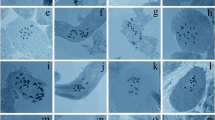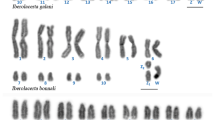Summary
-
1.
Of the ten species ofBanasa investigated, one has the typical chromosome complement of the TribePentatomini (2n=12+2 sex chromosomes); three have an extra pair of autosomes (2n=14+2 sex chromosomes); and six have doubled the number of autosomes (2n=24+2 sex chromosomes).
-
2.
The autosomes in the 26-chromosome species ofBanasa are distinctly smaller than in either the 14- or the 16-chromosome species, but the size of the sex chromosomes has undergone no such decrease.
-
3.
In five of the species in which the number of autosomes has been doubled, the DNA value remains close to that found in the presumably more primitive species with 14 chromosomes. No DNA data are available for the sixth species.
-
4.
It is concluded that the evidence argues against both polyploidy and an accumulation of random changes in chromosomal structure as primary factors in the evolution of the 26-chromosome species. It is proposed instead that the doubling of the autosome number is due to a separation and individuation of the two chromatids that compose each autosome.
-
5.
The suggestion is made that both chromatid autonomy and polyteny have played important roles in the chromosomal evolution of many other species also. But it is emphasized that only rarely can these two factors be solely responsible for evolutionary changes; fortuitous alterations in chromosome structure as well as true polyploidy (especially in plants) have also been involved in arriving at the conditions as we see them today.
Similar content being viewed by others
References
Ansley, H. R.: A cytological and cytophotometric study of alternative pathways of meiosis in the house centipede (Scutigera forcepsRafinesque). Chromosoma6, 656–695 (1954).
Bauer, H., andW. Beermann: Der Chromosomencyclus der Orthocladiinen(Nematocera), Diptera. Z. Naturforsch.7b, 557–563 (1952).
Bowen, R. H.: Studies on insect spermatogenesis IV. Proc. Amer. Acad. Arts Sci.57, 391–423 (1922).
Brown, S. W., andF. D. Bennet: On sex determination in the diaspine scalePseudaulacaspis pentagonaTarg (Coccidae). Genetics42, 510–523 (1957).
Goldschmidt, E.: Abnormal chromosome behavior in fairy shrimp (Euphyllopoda Anostraca). Caryologia6, Suppl., 781–784 (1954).
Håkanson, A., andA. Levan: Endo-duplicational meiosis inAllium odorum. Hereditas43, 179–200 (1957).
Hughes-Schrader, S.: Cytology of coccids (Coccoidea-Homoptera). Advanc. Genet.2, 127–203 (1948).
—: Differential polyteny and polyploidy in diaspine coccids (Homoptera-Coccidea). Chromosoma8, 709–718 (1957).
Hughes-Schrader, S., andF. Schrader: Polyteny as a factor in the chromosomal evolution of thePentatomini (Hemiptera). Chromosoma8, 135–151 (1956).
—: TheNezara complex (Pentatomidae-Heteroptera) and its taxonomic and cytological status. J. Morph.101, 1–24 (1957).
Lepori, N. G.: Ricerche sulla ovogenesi e sulla fecondazione nella planariaPolycelis nigraEhrenberg con particolare riguardo all’ufficia del nucleo spermatico. Caryologia1, 280–295 (1949).
Leuchtenberger, C., F. Schrader, S. Hughes-Schrader andP. W. Gregory: Certain cytochemical and cytological aspects of dwarfism in cattle. J. Morph.99, 481–512 (1956).
Lorkovi, Z.: Die Chromosomenzahlen in der Spermatogenese der Tagfalter. Chromosoma2, 155–191 (1941).
Manton, I.: Problems of cytology and evolution in thePteridophyta, Cambridge 1950.
Melander, Y.: Cytological studies on Scandinavian flatworms belonging toTricladida, Paludicola. Hereditas, Suppl.,1949 625–626.
—: Studies on the chromosomes ofUlophysema öresundense. Herditas36, 233–255 (1950).
Mirsky, A. E., andH. Ris: The desoxyribonucleic acid content of animal cells and its evolutionary significance. J. gen. Physiol.34, 451–462 (1951).
Muldal, S.: The chromosomes of the earthworms I. Heredity6, 55–76 (1952).
Omodeo, P.: Cariologia deiLumbricidae. Caryologia4, 173–275 (1952).
Ris, H.: Chromosome structure. (In The Chemical Basis of Heredity.) 23–62. Baltimore 1957.
Sailer, R. I.: Two new species ofBanasa from Central America (Hemiptera: Pentatomidae). Bull. Brooklyn ent. Soc.52, 85–88 (1957).
- Additional new species ofBanasa from the Caribbean area. Bull. Brooklyn Ent. Soc.53 (1958).
Schrader, P.: The elimination of chromosomes in the meiotic divisions ofBrachystethus rubromaculatusDallas. Biol. Bull.90, 19–31 (1946a).
—: Autosomal elimination and preferential segregation in the harlequin lobe of certainDiscocephalini (Hemiptera). Biol. Bull.90, 265–290 (1946b).
—: The role of the kinetochore in the chromosomal evolution of theHeteroptera andHomoptera. Evolution1, 134–142 (1947).
Schrader, F., andS. Hughes-Schrader: Polyploidy and fragmentation in the chromosomal evolution of various species ofThyanta (Hemiptera). Chromosoma7, 469–496 (1956).
White, M. J. D.: The evidence against polyploidy in sexually reproducing animals. Amer. Nat.80, 610–618 (1946).
Wilson, E. B.: Studies on chromosomes II. J. exp. Zool.11, 507–545 (1905).
—: Notes on the chromosome-groups ofMetapodius andBanasa. Biol. Bull.12, 303–313 (1907).
Author information
Authors and Affiliations
Additional information
This investigation was supported in part by research grant G-4370 from the National Institutes of Health, Public Health Service.
Rights and permissions
About this article
Cite this article
Schrader, F., Hughes-Schrader, S. Chromatid autonomy in Banasa (Hemiptera: Pentatomidae). Chromosoma 9, 193–215 (1957). https://doi.org/10.1007/BF02568075
Received:
Issue Date:
DOI: https://doi.org/10.1007/BF02568075




